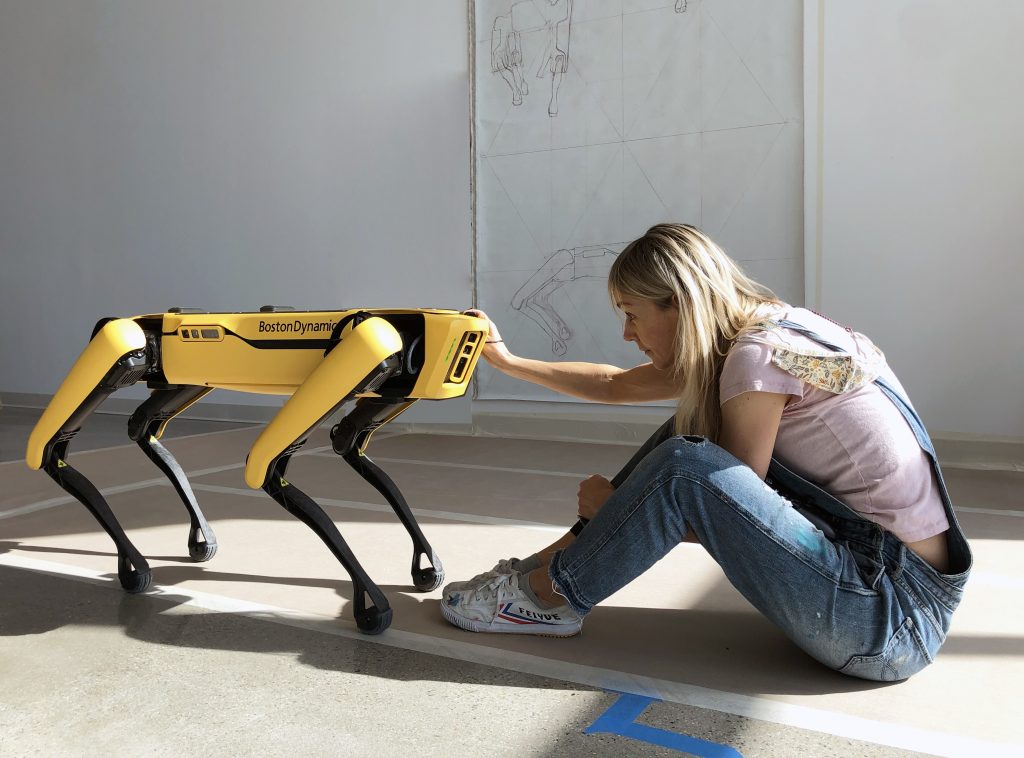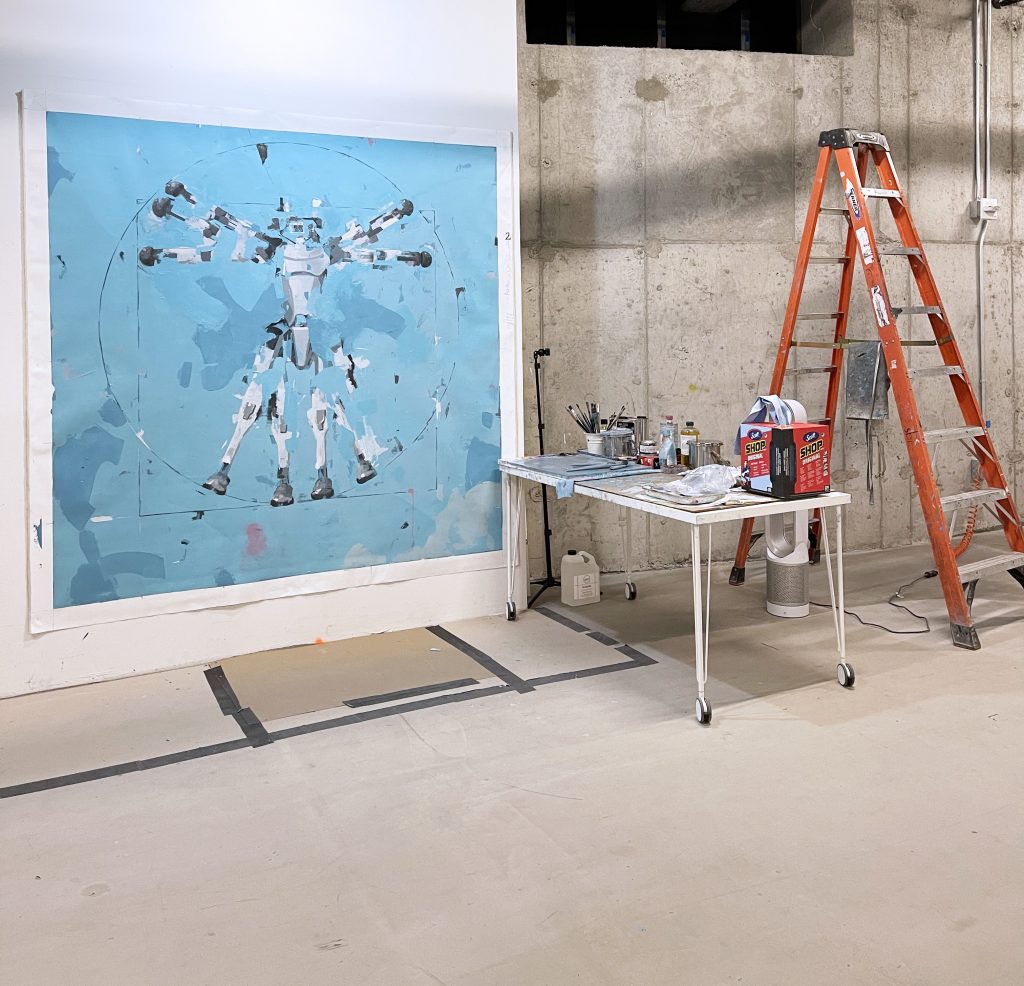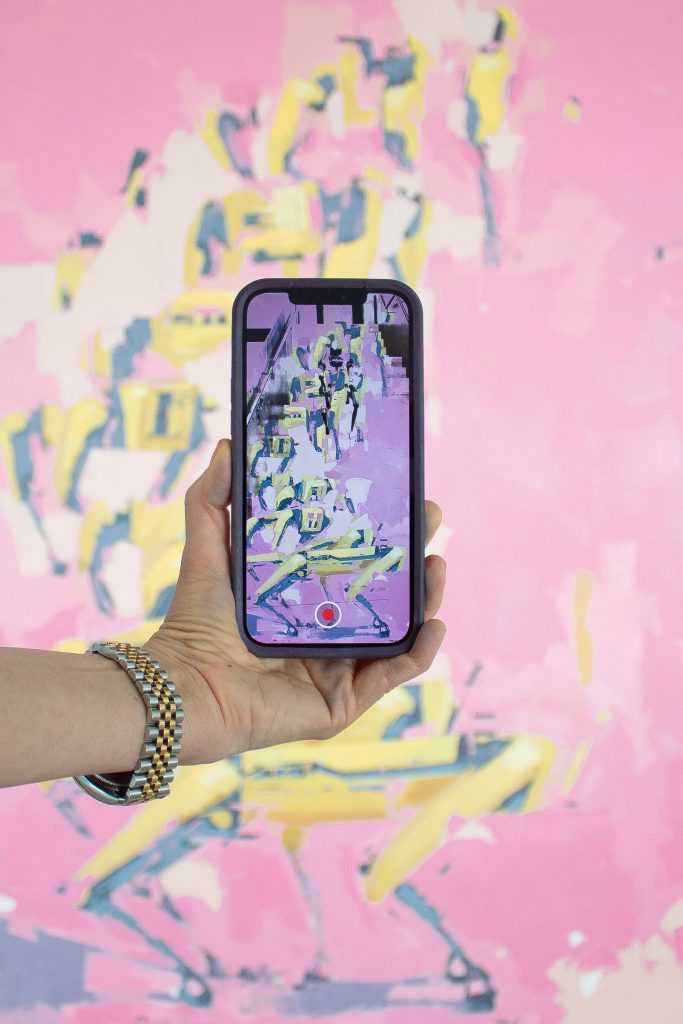People
‘Power in Society Is in the Machine’: Why Agnieszka Pilat Teamed Up With a Robo Dog Named Spot to Paint Our New Tech Overlords
Agnieszka Pilat is an artist in residence at Boston Dynamics and other tech companies.

Agnieszka Pilat is an artist in residence at Boston Dynamics and other tech companies.

Julie Baumgardner

The battle between man and machine is not exactly a new one—and the past decade of digital innovation has primed the collective consciousness even more toward A.I. and robots becoming our formidable challengers in the quest of power (said in an Adam Curtis voice).
Whether A.I. is actually the biggest threat to humanity remains to be seen, and perhaps determined by your stance on Elon Musk. But none of this scares Agnieszka Pilat. A painter classically trained in portraiture, Pilat has recently been garnering attention for her rather intimate relationship to robotics, even turning our feared foes into a muse.
“Muse is a good word,” Pilat said. “I never used that term before, but it makes so much sense now that you say it.” So who is the subject of her most recent body of work? Spot®, the agile mobile robot by Boston Dynamics, an A.I.-powered workhorse more commonly found deep in iron mines, nuclear sites, and among the French military than a painter’s studio.
“Right now, power in society is the machine, so I paint portraits of machines and technology,” she said. Equating technology to the new aristocracy may sound zealous, but portraiture—across all art production and history—has been the medium of power. Pilat does not mean the people behind technology, such as Musk, Jeff Bezos, or Peter Thiel, rather “I work for the machines. They are my patrons,” she said.

Stretching canvases in her San Francisco studio. Photo: Agnieszka Pilat.
Her evangelism around technology has been influenced by her adopted home of Silicon Valley and the Bay Area. (She’s originally from “communist Poland,” as she puts it.) But her ideas around tech and futurism have persuaded technology companies, including Boston Dynamics, Autodesk, and Shack15, to invite her in as their first artist in residence. Soon, too, the Virgin Galactic will be added to that list. “I told Richard [Branson], ‘Hey can I just come and work?’” she says giggling again, to which he agreed.
Pilat chose Spot as a subject to explore a dialogue with art history and show off his celebrity. Spot is perhaps the second most famous robot after Sophia, the Hanson Robotics humanoid who became the first machine to receive a national citizenship (from Saudi Arabia). But Spot, too, finds himself heavily discussed in the press and social media, and intrigue and fear have made this life-like machine a one-named star. A marvel to some and notorious to many, Pilat sees Spot as hanging one day in Western art history alongside the faces by Anthony Van Dycks, Thomas Gainsboroughs and Andy Warhols.
“If Warhol were alive, I don’t think he’d be painting portraits of celebrities,” Pilat said. Instead, those 15 minutes of fame would be delegated to “tech people.”

The artist’s rendition of Leonardo’s Vitruvian Man. Photo: Agnieszka Pilat.
So, Pilat beckoned the classics of portraiture and recomposed them with Spot for a series titled “Renaissance 2.0,” recently shown at Modernism, the stalwart San Francisco gallery run by Martin Muller (who, as it happens, first brought Warhol to the West). Marcel Duchamp’s Nude Descending a Staircase is now rendered with Spot in motion. Leonardo Da Vinci’s Vitrivuian Man? Spot outstretched in ways not physically possible, mimicking the famed experiment in proportion by the polymath Renaissance man. Even the Sistine Chapel’s Creation of Adam finds itself rethought with Spot’s legs and pincers stretching to give itself life.
“I humanize Spot all the time,” Pilat said. So much so, that she even engaged Spot to be a studio assistant of sorts. When Pilat was in residence at Boston Dynamics for a year, setting up shop in their Waltham, Massachusetts, campus, she had a thought as she worked on the portraits: “Why don’t I use the robot like my own student, to make it work?”
And so she did. Pilat was able to program Spot to draw by dragging oil sticks that she affixed to a 50-pound lode that acts as an arm attached to the robot’s body. Pilat gives directives through an iPad that Spot follows on canvases Pilat had stretched, primed, and pre-painted.
So far, Spot is only capable of straight lines and simple gestural marks, and needs to be assisted by a human to grab the oil sticks (though Spot can be remotely programmed by Pilat). “It seems like the machine has its own agency but it doesn’t really,” she said. “Spot is an industrial machine, clearly not a toy, but it moves in a way that honors nature.”

Agnieszka Pilat’s rendition of Duchamp’s Nude Descending a Staircase.
While Spot may not yet be a Da Vinci itself, its paintings are en route to building up a formidable secondary market, as well as a crypto one with a soon-to-be announced NFT venture. Most recently, at Sotheby’s selling exhibition “Boundless Space… The Possibilities of Burning Man,” Pilat’s painting B70 Self Portrait 02, made in collaboration with Spot, sold for $31,500.
Her forthcoming NFT project will continue her collaboration with Spot, fusing its painting data with an original Spot edition painted specifically for the NFT owner. That’s all we can say for now—but if you can’t wait to engage with Pilat’s work until then, there’s her series on view in “The Matrix Resurrections.”
“I developed a real emotional relation to Spot. I really connected with it,” said Pilat, who has become accustomed to taking Spot for walks, public events, and even as a guest to the dinner parties of Silicon Valley billionaires. “Having the robot around really opens the conversation,” especially around technophobia, as well as abuse of these innovations.
“It’s important to engage with the machines and treat them like very thoughtful parents would,” she said. If robots are the future power centers of our own creation, shouldn’t we care how they are programmed and raised? “Yes!” exclaimed Pilat “This is about elevating technology and making it cultured.”